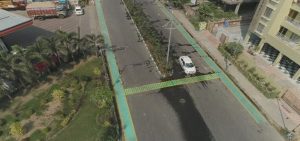 GOVERNMENT
OF INDIA
GOVERNMENT
OF INDIA
Please login using your email address as it is mandatory to access all the services of community.data.gov.in
 GOVERNMENT
OF INDIA
GOVERNMENT
OF INDIA
Background:
The app-based public bicycle sharing system was launched in September 2020. The technology-led public bicycle sharing system along with the well-connected cycling bays across the city, has ensured end-to-end connectivity across all major locations of footfall in the city. The city authorities have constructed green bollards along the green cycling bays in New Town to prohibit motor-vehicle encroachment onto the cycling tracks or bays.
The infrastructure for the app based bicycles was developed and refined by analysing data from field surveys as well as cycle concentration analysis from the “PBS” application dashboard through inbuilt GPS trackers fitted into every bicycle.
Objectives:
• Introduction of app-based public bicycle sharing systems to increase the last mile connectivity in the city
• Identification of the areas and routes for cycle docking stations and tracks through citizen surveys and cycle concentration analysis
• Increase in ease of ridership through accessibility by identifying demand locations
• Reduction in carbon footprint of the city
Public Bicycle Sharing System Features
• 400 pedal bicycles, 100 E-bikes, 21 docking stations across major locations in New Town
• App-based Public Bicycle Sharing system is funded through a VGF model – and is one of the most budget friendly commute options
• PBS Map based Dashboard displaying cycle concentration, active rides and active subscriptions
Use of the PBS Data for Planning of Docking Stations and Cycle Lanes
Initially only 5 docking stations were identified for the bicycles and only 100 bicycles were deployed.
To scale up this system, there was a need to:
The data on the travel pattern of citizen of New Town, available on the PBS dashboard, has enabled the city authority to revisit its planning for the cycle docking stations in the city. For example, during the initial stages of planning, the city authority of New Town did not plan for a cycle docking station near Coffee House in Action Area II of New Town. However, noticing increasing demand for cycles from this area, through the PBS dashboard the authority revisited its decision and added a new cycle docking station in this area. It is pertinent to mention here that there are educational institutes like Amity and Aliah Universities in the vicinity of the new docking station and PBS enjoys significant popularity among the students. Again, based on the data available, the city authority relocated one of the two docking stations planned near Jute Corporation Building and constructed it close to the Chittaranjan National Cancer Institute (CNCI) hospital. Moreover, not only were cycle docking stations installed, additional at-grade cycle lanes were introduced in the area.
 Figure 2: Map-based PBS Dashboard showcasing the concentration and locations of rented bicycles
Figure 2: Map-based PBS Dashboard showcasing the concentration and locations of rented bicycles
Moreover, before commissioning of the PBS project in New Town, multiple handlebar surveys were undertaken in New Town to understand the pain points of citizens with regard to adoption of cycling as a preferred mode of transport. Based on the data available from the survey, it was understood that there was need for introduction of cycle signages in New Town. Based on this data cycle signages were introduced and their locations identified to improve the experience and safety and security of cyclists in the city.
In addition, the handlebar surveys identified major issues with the cycling infrastructure of New Town such as discontinuity of cycle tracks, improper gradients, lack of parking etc. These issues assisted the urban planners to construct additional cycle tracks and signages and secure funding for the same.
 Figure 3: Findings of 1st Handlebar Survey
Figure 3: Findings of 1st Handlebar Survey

Figure 4: Findings of 2nd Handlebar Survey to monitor progress compared to the first survey
 Figure 5: Findings of User Perception survey to identify demographic profile, barriers to cycling and infrastructure demand by end-users.
Figure 5: Findings of User Perception survey to identify demographic profile, barriers to cycling and infrastructure demand by end-users.
The above surveys were used to plan, design and get budgetary approvals for additional infrastructure. Consequently approximately 35 km of cycle tracks were constructed throughout New Town post September, 2020 when the PBS project was launched.
 Figure 6: New Cycle tracks constructed by utilizing the survey inputs
Figure 6: New Cycle tracks constructed by utilizing the survey inputs
Results Achieved:
• New Town recognized as one of the top 25 most cycle friendly cities in the country
• Analysed Bicycle ridership data to ensure that 197% extra demand for rides is met in October 2021 (on occasion of Dussehra) compared to September 2021 (19,291 vs 6489 rides respectively)
• Total rides between Jan – Dec 2021 – 78607
• Total cumulative distance covered between Jan – Dec 2021 -1,58,699 Km
• 48,701 Kg CO2 offset from 1st October, 2020 to 18th January, 2022
• Enhanced aesthetics of the city, with colourful signages, cycling tracks, pedestrian walkways, cycle stands and cycle docking stations and EV charging stations adorning the city scape. The locations were identified using a mix of bicycle sensor data and citizen feedback.
• Increased sense of safety among citizens, especially among women citizens as rides can be shared on social media
• These electric powered bicycles are being used by small traders, who deliver grocery items and drinking water to households thus enhancing the local economy’s last mile connectivity. There are several other instances of local pharmacies and groceries availing of the well-connected, dedicated cycling bays in New Town for fast and seamless delivery.